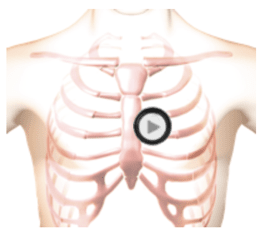Acute Pericarditis C9
Here we present an example of acute pericarditis as auscultated at Erb's Point. Murmurs are caused by turbulent blood flow across incompetent or stenotic valves. In contrast, a pericardial friction rub is caused by the rubbing together of two surfaces of the pericardial sack. The pericardial friction rub has three parts; a systolic component, an early diastolic component and a late diastolic component. The first and second heart sounds are obscured by the rubbing sounds. In the anatomy video you can see the yellow fluid accumulation around the heart caused by an inflamed pericardial sack.Auscultation Sounds


Patient Recording of Acute Pericarditis C9


Patient Recording - Half Speed


Position

The patient's position should be sitting leaning forward.
Listening Tips for Acute Pericarditis C9
S1:Rubbing, scratchy soundSystole:Rubbing, scratchy sound, usually loudest during systole
S2:Rubbing, scratchy sound
Diastole:Rubbing, scratchy sound
Waveform (Phonocardiogram)
Observe Cardiac Animation for Acute Pericarditis C9
Review the cardiac animation and notice the yellow fluid accumulation around the heart caused by an inflamed pericardial sack.
Authors and Sources
Authors and Reviewers
- EKG heart rhythm modules: Thomas O'Brien.
- EKG monitor simulation developer: Steve Collmann
-
12 Lead Course: Dr. Michael Mazzini, MD.
- Spanish language EKG: Breena R. Taira, MD, MPH
- Medical review: Dr. Jonathan Keroes, MD
-
Heart sounds and mentorship: W. Proctor Harvey, MD
- Medical review: Dr. Pedro Azevedo, MD, Cardiology
-
Last Update: 1/8/2023
Sources
-
Electrocardiography for Healthcare Professionals, 5th Edition
Kathryn Booth and Thomas O'Brien
ISBN10: 1260064778, ISBN13: 9781260064773
McGraw Hill, 2019 -
Rapid Interpretation of EKG's, Sixth Edition
Dale Dublin
Cover Publishing Company -
12 Lead EKG for Nurses: Simple Steps to Interpret Rhythms, Arrhythmias, Blocks, Hypertrophy, Infarcts, & Cardiac Drugs
Aaron Reed
Create Space Independent Publishing -
Heart Sounds and Murmurs: A Practical Guide with Audio CD-ROM 3rd Edition
Elsevier-Health Sciences Division
Barbara A. Erickson, PhD, RN, CCRN - Clinical Heart Disease
W Proctor Harvey, MD
Clinical Heart Disease
Laennec Publishing; 1st edition (January 1, 2009) -
The Virtual Cardiac Patient: A Multimedia Guide to Heart Sounds, Murmurs, EKG
Jonathan Keroes, David Lieberman
Publisher: Lippincott Williams & Wilkin)
ISBN-10: 0781784425; ISBN-13: 978-0781784429 - Project Semilla, UCLA Emergency Medicine, EKG Training Breena R. Taira, MD, MPH
Acute Pericarditis C9 | Lessons with Audio and Video | #106